1. Hughes K, Bellis MA, Hardcastle KA, Sethi D, Butchart A, Mikton C, et al. The effect of multiple adverse childhood experiences on health: a systematic review and meta-analysis. Lancet Public Health. 2017; 2(8):e356–e366. PMID:
29253477.

2. Kim J, Cicchetti D. Longitudinal pathways linking child maltreatment, emotion regulation, peer relations, and psychopathology. J Child Psychol Psychiatry. 2010; 51(6):706–716. PMID:
20050965.

3. Carr CP, Martins CM, Stingel AM, Lemgruber VB, Juruena MF. The role of early life stress in adult psychiatric disorders: a systematic review according to childhood trauma subtypes. J Nerv Ment Dis. 2013; 201(12):1007–1020. PMID:
24284634.
4. Buisman RSM, Pittner K, Tollenaar MS, Lindenberg J, van den Berg LJM, Compier-de Block LHCG, et al. Intergenerational transmission of child maltreatment using a multi-informant multi-generation family design. PLoS One. 2020; 15(3):e0225839. PMID:
32163421.

5. Stoltenborgh M, van Ijzendoorn MH, Euser EM, Bakermans-Kranenburg MJ. A global perspective on child sexual abuse: meta-analysis of prevalence around the world. Child Maltreat. 2011; 16(2):79–101. PMID:
21511741.

6. Hong J, Lee NY, Park H, Faller K. Child maltreatment in South Korea: an ecological systems analysis. Child Youth Serv Rev. 2011; 33(7):1058–1066.

7. Chang J, Rhee S, Weaver D. Characteristics of child abuse in immigrant Korean families and correlates of placement decisions. Child Abuse Negl. 2006; 30(8):881–891. PMID:
16939691.

8. Huh HJ, Kim KH, Lee HK, Chae JH. The relationship between childhood trauma and the severity of adulthood depression and anxiety symptoms in a clinical sample: the mediating role of cognitive emotion regulation strategies. J Affect Disord. 2017; 213:44–50. PMID:
28189964.

9. Choi JY, Choi YM, Kim B, Lee DW, Gim MS, Park SH. The effects of childhood abuse on self-reported psychotic symptoms in severe mental illness: mediating effects of posttraumatic stress symptoms. Psychiatry Res. 2015; 229(1-2):389–393. PMID:
26144585.

10. Park A, Chung IJ. Patterns of adverse childhood experiences and their influences on depressive symptoms, difficulty in emotion regulation, and interpersonal maladjustment. Korean J Child Stud. 2018; 39(6):85–99.

11. World Health Organization. CIDI, Core Version 2.1 Trainer's Manual. Geneva, Switzerland: WHO;1997. p. 1–244.
12. World Health Organization. CIDI, Core Version 2.1 Interviewer's Manual. Geneva, Switzerland: WHO;1997. p. 1–114.
13. Lee J, Kim H, Woo J, Chang SM, Hong JP, Lee DW, et al. Impacts of remaining single above the mean marriage age on mental disorders and suicidality: a nationwide study in Korea. J Korean Med Sci. 2020; 35(37):e319. PMID:
32959544.

14. Hovdestad W, Campeau A, Potter D, Tonmyr L. A systematic review of childhood maltreatment assessments in population-representative surveys since 1990. PLoS One. 2015; 10(5):e0123366. PMID:
25993481.

15. Janssen I, Krabbendam L, Bak M, Hanssen M, Vollebergh W, de Graaf R, et al. Childhood abuse as a risk factor for psychotic experiences. Acta Psychiatr Scand. 2004; 109(1):38–45. PMID:
14674957.

17. Jeon JR, Lee EH, Lee SW, Jeong EG, Kim JH, Lee D, et al. The early trauma inventory self report-short form: psychometric properties of the Korean version. Psychiatry Investig. 2012; 9(3):229–235.

18. Burchell B, Marsh C. The effect of questionnaire length on survey response. Qual Quant. 1992; 26(3):233–244.

19. Robins LN, Wing J, Wittchen HU, Helzer JE, Babor TF, Burke J, et al. The Composite International Diagnostic Interview. An epidemiologic instrument suitable for use in conjunction with different diagnostic systems and in different cultures. Arch Gen Psychiatry. 1988; 45(12):1069–1077. PMID:
2848472.
20. Bertolote JM, Fleischmann A, De Leo D, Bolhari J, Botega N, De Silva D, et al. Suicide attempts, plans, and ideation in culturally diverse sites: the WHO SUPRE-MISS community survey. Psychol Med. 2005; 35(10):1457–1465. PMID:
16164769.

21. Green JG, McLaughlin KA, Berglund PA, Gruber MJ, Sampson NA, Zaslavsky AM, et al. Childhood adversities and adult psychiatric disorders in the national comorbidity survey replication I: associations with first onset of DSM-IV disorders. Arch Gen Psychiatry. 2010; 67(2):113–123. PMID:
20124111.
23. Afifi TO, Mather A, Boman J, Fleisher W, Enns MW, Macmillan H, et al. Childhood adversity and personality disorders: results from a nationally representative population-based study. J Psychiatr Res. 2011; 45(6):814–822. PMID:
21146190.

24. Wade R Jr, Cronholm PF, Fein JA, Forke CM, Davis MB, Harkins-Schwarz M, et al. Household and community-level Adverse Childhood Experiences and adult health outcomes in a diverse urban population. Child Abuse Negl. 2016; 52:135–145. PMID:
26726759.

25. Taillieu TL, Brownridge DA, Sareen J, Afifi TO. Childhood emotional maltreatment and mental disorders: results from a nationally representative adult sample from the United States. Child Abuse Negl. 2016; 59:1–12. PMID:
27490515.

26. Tonmyr L, Draca J, Crain J, Macmillan HL. Measurement of emotional/psychological child maltreatment: a review. Child Abuse Negl. 2011; 35(10):767–782. PMID:
22018520.

27. Kenny MC, McEachern AG. Racial, ethnic, and cultural factors of childhood sexual abuse: a selected review of the literature. Clin Psychol Rev. 2000; 20(7):905–922. PMID:
11057377.
28. Song DH. Child sexual abuse and nation-funded child sexual abuse protection center (Sunflower center). J Korean Neuropsychiatr Assoc. 2020; 59(3):196–201.

30. Zhai F, Gao Q. Child maltreatment among Asian Americans: characteristics and explanatory framework. Child Maltreat. 2009; 14(2):207–224. PMID:
18971344.
31. Oyserman D, Coon HM, Kemmelmeier M. Rethinking individualism and collectivism: evaluation of theoretical assumptions and meta-analyses. Psychol Bull. 2002; 128(1):3–72. PMID:
11843547.

32. Futa KT, Hsu E, Hansen DJ. Child sexual abuse in Asian American families: an examination of cultural factors that influence prevalence, identification, and treatment. Clin Psychol. 2001; 8(2):189–209.

33. Merrick MT, Ports KA, Ford DC, Afifi TO, Gershoff ET, Grogan-Kaylor A. Unpacking the impact of adverse childhood experiences on adult mental health. Child Abuse Negl. 2017; 69:10–19. PMID:
28419887.

34. Copeland WE, Shanahan L, Hinesley J, Chan RF, Aberg KA, Fairbank JA, et al. Association of childhood trauma exposure with adult psychiatric disorders and functional outcomes. JAMA Netw Open. 2018; 1(7):e184493. PMID:
30646356.

35. Kassel JD, Jackson SI, Unrod M. Generalized expectancies for negative mood regulation and problem drinking among college students. J Stud Alcohol. 2000; 61(2):332–340. PMID:
10757145.

36. Parrott AC. Cigarette-derived nicotine is not a medicine. World J Biol Psychiatry. 2003; 4(2):49–55. PMID:
12692774.

37. Hankin BL. Childhood maltreatment and psychopathology: prospective tests of attachment, cognitive vulnerability, and stress as mediating processes. Cognit Ther Res. 2005; 29(6):645–671.

38. Heim C, Newport DJ, Bonsall R, Miller AH, Nemeroff CB. Altered pituitary-adrenal axis responses to provocative challenge tests in adult survivors of childhood abuse. Am J Psychiatry. 2001; 158(4):575–581. PMID:
11282691.

39. Gutiérrez B, Bellón JÁ, Rivera M, Molina E, King M, Marston L, et al. The risk for major depression conferred by childhood maltreatment is multiplied by BDNF and SERT genetic vulnerability: a replication study. J Psychiatry Neurosci. 2015; 40(3):187–196. PMID:
25510949.

40. Stein MB, Schork NJ, Gelernter J. Gene-by-environment (serotonin transporter and childhood maltreatment) interaction for anxiety sensitivity, an intermediate phenotype for anxiety disorders. Neuropsychopharmacology. 2008; 33(2):312–319. PMID:
17460615.

41. Mehta D, Binder EB. Gene × environment vulnerability factors for PTSD: the HPA-axis. Neuropharmacology. 2012; 62(2):654–662. PMID:
21439305.
42. Bomyea J, Risbrough V, Lang AJ. A consideration of select pre-trauma factors as key vulnerabilities in PTSD. Clin Psychol Rev. 2012; 32(7):630–641. PMID:
22917742.

43. Afifi TO, Boman J, Fleisher W, Sareen J. The relationship between child abuse, parental divorce, and lifetime mental disorders and suicidality in a nationally representative adult sample. Child Abuse Negl. 2009; 33(3):139–147. PMID:
19327835.

44. Fujiwara T, Kawakami N. World Mental Health Japan Survey Group. Association of childhood adversities with the first onset of mental disorders in Japan: results from the World Mental Health Japan, 2002-2004. J Psychiatr Res. 2011; 45(4):481–487. PMID:
20728903.

45. Beatty MJ, Heisel AD, Hall AE, Levine TR, La France BH. What can we learn from the study of twins about genetic and environmental influences on interpersonal affiliation, aggressiveness, and social anxiety?: a meta-analytic study. Commun Monogr. 2002; 69(1):1–18.

46. Van Houtem CM, Laine ML, Boomsma DI, Ligthart L, van Wijk AJ, De Jongh A. A review and meta-analysis of the heritability of specific phobia subtypes and corresponding fears. J Anxiety Disord. 2013; 27(4):379–388. PMID:
23774007.

47. Monzani B, Rijsdijk F, Harris J, Mataix-Cols D. The structure of genetic and environmental risk factors for dimensional representations of DSM-5 obsessive-compulsive spectrum disorders. JAMA Psychiatry. 2014; 71(2):182–189. PMID:
24369376.
48. Schumacher J, Kristensen AS, Wendland JR, Nöthen MM, Mors O, McMahon FJ. The genetics of panic disorder. J Med Genet. 2011; 48(6):361–368. PMID:
21493958.

49. Chou KL. Childhood sexual abuse and psychiatric disorders in middle-aged and older adults: evidence from the 2007 Adult Psychiatric Morbidity Survey. J Clin Psychiatry. 2012; 73(11):e1365–e1371. PMID:
23218165.
50. Lochner C, Seedat S, Allgulander C, Kidd M, Stein D, Gerdner A. Childhood trauma in adults with social anxiety disorder and panic disorder: a cross-national study. Afr J Psychiatry (Johannesbg). 2010; 13(5):376–381. PMID:
21390408.

51. Mathews CA, Kaur N, Stein MB. Childhood trauma and obsessive-compulsive symptoms. Depress Anxiety. 2008; 25(9):742–751. PMID:
17557315.

52. Wardenaar KJ, Lim CCW, Al-Hamzawi AO, Alonso J, Andrade LH, Benjet C, et al. The cross-national epidemiology of specific phobia in the World Mental Health Surveys. Psychol Med. 2017; 47(10):1744–1760. PMID:
28222820.

53. Stein DJ, Lim CCW, Roest AM, de Jonge P, Aguilar-Gaxiola S, Al-Hamzawi A, et al. The cross-national epidemiology of social anxiety disorder: data from the World Mental Health Survey Initiative. BMC Med. 2017; 15(1):143. PMID:
28756776.

54. Pechtel P, Pizzagalli DA. Effects of early life stress on cognitive and affective function: an integrated review of human literature. Psychopharmacology (Berl). 2011; 214(1):55–70. PMID:
20865251.

55. Hoertel N, Franco S, Wall MM, Oquendo MA, Wang S, Limosin F, et al. Childhood maltreatment and risk of suicide attempt: a nationally representative study. J Clin Psychiatry. 2015; 76(7):916–923. PMID:
26231006.
56. McGowan PO, Sasaki A, D'Alessio AC, Dymov S, Labonté B, Szyf M, et al. Epigenetic regulation of the glucocorticoid receptor in human brain associates with childhood abuse. Nat Neurosci. 2009; 12(3):342–348. PMID:
19234457.

57. Thompson MP, Kingree JB, Lamis D. Associations of adverse childhood experiences and suicidal behaviors in adulthood in a U.S. nationally representative sample. Child Care Health Dev. 2019; 45(1):121–128. PMID:
30175459.

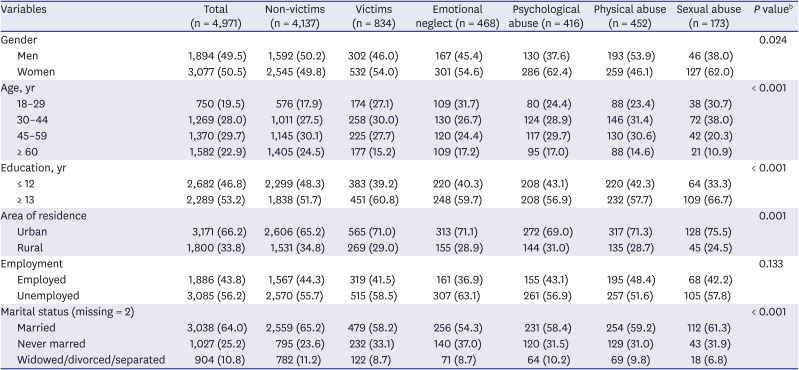
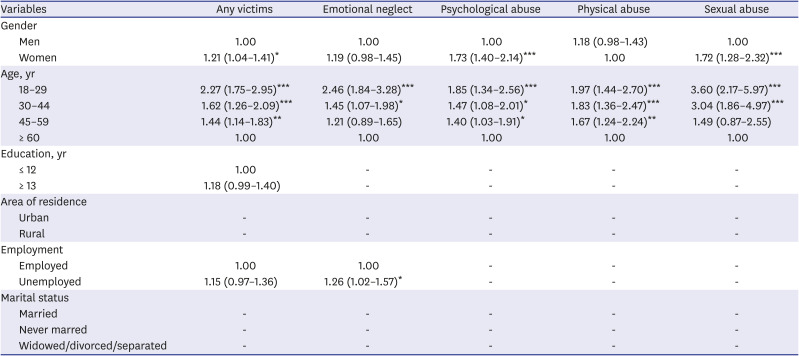
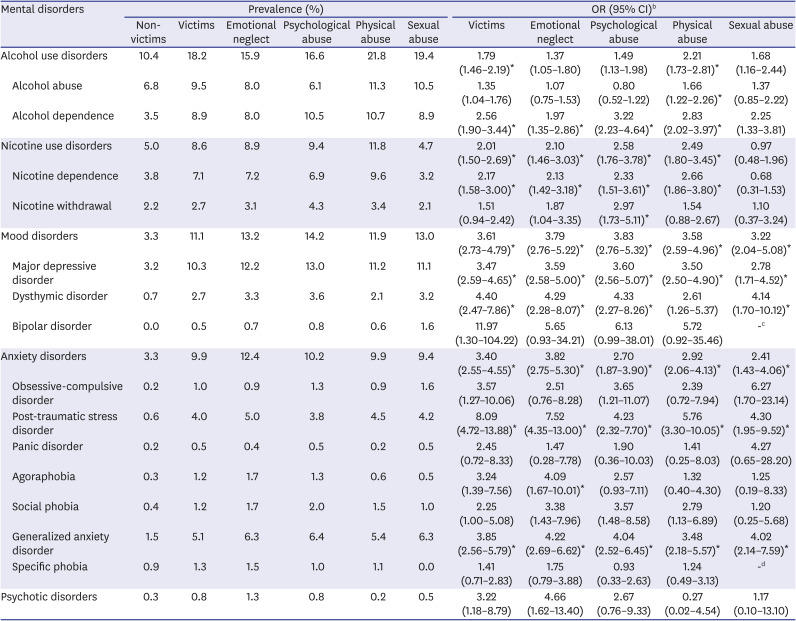
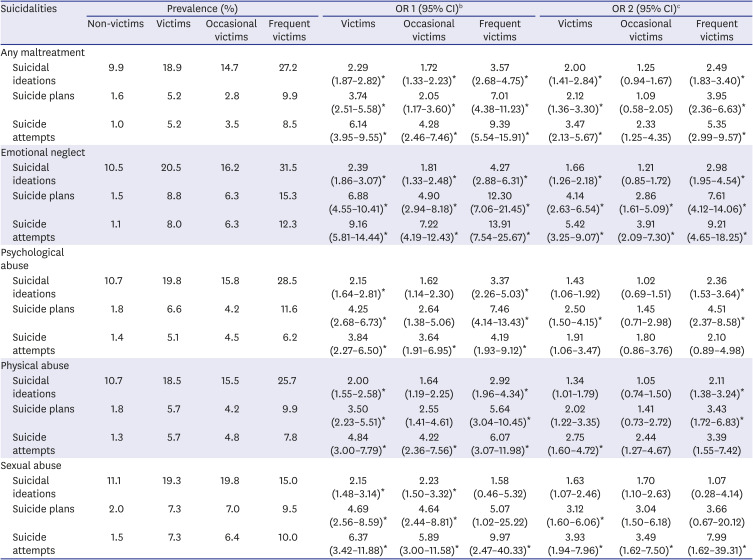




 PDF
PDF Citation
Citation Print
Print



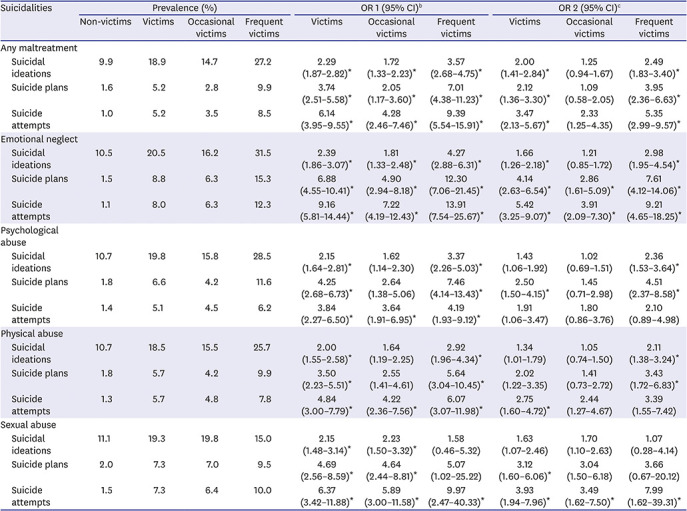
 XML Download
XML Download